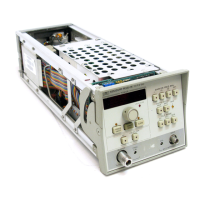A4 ALC TROUBLESHOOTING (CHANGE 8) (Cont'd)
The waveform in Figure 8-32 should be seen at TP2. Note that the exercise routine for the 12-bit
DAC yields a staircased waveform with 13 levels. The first step shows the maximum
+
10
Vdc
output with all bits high. The following levels represent the-voltage at TP2 with successive bits
loaded high in order from the Most Significant Bit to the Least Significant Bit.
If the waveform at TP2 is not correct, check for
-
10V REF, and trace any problem back to
the A8 assembly. Look for activity on
L
INSTI, BAO, and BAl. BA2 and BA3 should pulse
high as each new DAC value is loaded, pulsing the CS line (U14 pin 8) low. If any of these
lines, or a data line, appears dead, trace the problem back to the A3 assembly.
U2A
adds PWR SWP/COMP and
AM,
and provides detector flatness compensation at higher
power levels with CR2 and
CRl. Use the EXT MTR mode to bypass these diodes while
troubleshooting.
U2C adds the amplitude markers
(L
1 DB MKR), and the front panel amplitude adjustment
.
(EXT CAL) used with external leveling. The following levels should be seen at TPl with A5
removed and INT leveling selected:
+0.3 Vdc for
-
2 dBm, and
+
7.0
Vdc for
+
22 dBm.
Amplitude markers produce a 250 mVdc dip when the MKR light is on. An amplitude
modulation
(AM)
signal of fl.kO V p-p at P1-4 will produce roughly 260 mV p-p
at
TPl.
DETECTORS
/
DETECTOR SELECTION SWITCH B, DC1
The detector DCl is tested simply by checking its output voltage under full leveled power or full
unleveled power conditions. The
A4
assembly must be installed for troubleshooting as it
supplies bias current to the detector.
NOTE
The 27.8
kHz
modulation signal required for HP 8756A com-
patibility is not available from the Model
8350A/B when the A4
assembly is removed from the plug-in, and must
be
supplied from
the HP
8756A through one of its rear panel MODULATOR DRIVE
connectors.
If no power is measured, turn off the line power and remove the
A4
assembly. Return power
to the instrument. (If there is still no RF power, suspect components of the
RF
path. Refer
to RF Troubleshooting.) If full unleveled RF power is obtained, apply a narrow strip of
cellophane tape to the
pinedge connector at PI-44 to isolate the output of the modulator
driver from the modulator. Reinstall the A4 board. This removes bias from the modu-
lators, allowing full RF power transmission, while providing detector bias.
If full leveled power
(+
13 dBm) or full unleveled power (at least
+
15
dBm) is measured,
sweep the full band and check the voltage at the detector input against the values shown in
Table
8-9. (Use high impedance 10:l probes.)
CHANGE
8

